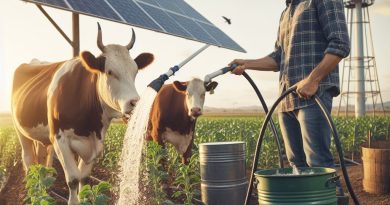Dairy Farming: Maximizing Milk Yield
Last Updated on January 25, 2024
Introduction
Dairy farming plays a crucial role in our food production system and the economy. It involves the rearing and management of cows, goats, or buffaloes for milk production.
Maximizing milk yield is essential for dairy farmers to ensure profitability and meet the increasing demand for dairy products.
Maximizing milk yield in dairy farming has numerous benefits.
Firstly, it allows farmers to meet the rising demand for milk and dairy products, especially with the growing population.
Secondly, higher milk yield improves the financial viability of dairy farms by increasing their potential revenue.
Additionally, efficient milk production promotes sustainability and reduces the environmental impact of dairy farming.
By implementing strategies to maximize milk yield, such as proper nutrition, breeding techniques, and effective herd management, dairy farmers can ensure a consistent and abundant supply of milk.
This, in turn, enables them to meet market demand, offer competitive prices, and contribute to the overall growth of the dairy industry.
Moreover, maximizing milk yield also leads to enhanced animal welfare. The health and well-being of dairy animals are directly related to milk production.
Therefore, by optimizing milk yield, farmers can focus on providing better hygiene, healthcare, and comfortable living conditions for their livestock.
In short, maximizing milk yield is of utmost importance in dairy farming. It not only ensures profitability and competitiveness but also supports sustainable practices and animal welfare.
By prioritizing milk yield, dairy farmers can thrive in the industry and contribute to meeting the growing demand for milk and dairy products.
The Role of Genetics
Genetics play a crucial role in maximizing milk yield in the dairy farming industry.
By selectively breeding cows and using genetic testing and technologies, farmers can greatly improve the productivity of their herds.
Significance of Genetics in Maximizing Milk Yield
Genetics form the foundation of dairy farming when it comes to maximizing milk yield.
Cows with superior genetic traits are more likely to produce higher quantities of milk compared to those with inferior genetics.
This is because certain genetic variations are directly linked to milk production capabilities.
By understanding and manipulating genetics, farmers can enhance the overall productivity and profitability of their dairy operations.
This enables them to meet the increasing demand for dairy products while ensuring sustainable and efficient milk production.
Selective Breeding and Improving Productivity in Dairy Cows
Selective breeding is an essential practice used to improve productivity in dairy cows.
By pairing the bulls with the best genetic traits with high-producing cows, farmers can pass on desirable characteristics to future generations.
This process helps to develop a genetically superior herd that is capable of producing more milk.
When selecting bulls for breeding, farmers look for qualities such as high milk production, strong immune systems, and efficient feed conversion.
By focusing on desired traits, they can gradually enhance the genetic potential of their herd over time, resulting in increased milk productivity.
Additionally, selective breeding can also reduce the likelihood of genetic disorders and health issues in the herd.
By avoiding mating combinations that might pass on undesirable traits, farmers can mitigate health risks and improve the overall well-being of their cows.
The Use of Genetic Testing and Technologies
In modern dairy farming, genetic testing and technologies play a vital role in maximizing milk yield.
Genetic testing allows farmers to analyze the genetic makeup of their cows and identify desirable traits for breeding purposes.
Through genetic testing, farmers can identify cows with high milk production potential, disease resistance, and other economically beneficial traits.
This knowledge enables them to make informed decisions regarding breeding and culling, optimizing the genetic potential of their herd.
Furthermore, technologies such as artificial insemination (AI) allow farmers to use high-quality semen from genetically superior bulls.
This helps to ensure that the offspring inherit desirable genetic traits, further improving milk yield in future generations.
Genetic technologies also allow for the identification of genetic disorders and diseases.
Through DNA testing, farmers can identify carriers of certain genetic conditions and avoid breeding them, reducing the risk of passing on such disorders to future generations.
In essence, genetics play a crucial role in maximizing milk yield in dairy farming.
By selectively breeding cows, utilizing genetic testing, and employing technologies, farmers can improve the productivity and genetic potential of their herds.
This not only benefits their own operations but also meets the increasing demand for milk and dairy products in a sustainable and efficient manner.
Read: Alpaca Feed Tips: Nutrition for Fleece Quality
Nutrition and Feeding Practices
Proper nutrition plays a crucial role in maximizing milk yield in dairy farming.
A balanced diet and correct feeding practices are essential for the overall health and productivity of dairy cows.
The Importance of Proper Nutrition
To achieve optimal milk production, providing the right nutrients in the cow’s diet is crucial.
Proper nutrition ensures the cow’s body receives adequate resources to support milk synthesis and maintain its overall health.
A well-balanced diet helps meet the cow’s energy, protein, vitamin, and mineral requirements. These nutrients are essential for lactation and play a significant role in milk yield.
Role of Balanced Diets and Correct Feeding Practices
Maximizing milk yield heavily relies on feeding cows a balanced diet that meets their specific nutritional needs throughout each stage of lactation.
A balanced diet should consist of high-quality forages, such as alfalfa and grass, along with grains and supplements.
It’s essential to formulate rations that meet the cow’s energy requirements without exceeding them, as excessive energy can lead to health issues, such as metabolic disorders.
Correct feeding practices involve providing a well-structured diet, offering consistent and adequate amounts of feed, and ensuring access to fresh and clean water at all times.
Feeding cows with consistent amounts of well-formulated rations helps maintain rumen health and stable microbial activity, which, in turn, maximizes nutrient utilization from feedstuffs.
Importance of Adequate Nutrients
Protein is a crucial nutrient for milk production.
It’s essential to provide sufficient amounts of protein in the cow’s diet, as inadequate protein can negatively impact milk yield and cow health.
High-quality protein sources like soybean meal or canola meal help meet these requirements.
Energy is another critical factor. Ensuring that the cow’s diet provides sufficient energy prevents drops in milk production and promotes overall cow health. The energy content can be met through grains, such as corn or barley, which are high in starch.
Vitamins and minerals are necessary for various metabolic processes in the cow’s body.
Adequate vitamin and mineral supplementation, along with a well-balanced diet, ensure optimal milk production, reproduction, immune function, and overall cow well-being.
Calcium, phosphorus, and magnesium are important minerals to focus on, as their deficiencies can affect milk production and cow health.
These minerals can be supplemented through high-quality mineral mixes
In summary, proper nutrition and feeding practices are of utmost importance in maximizing milk yield in dairy farming.
Providing balanced diets that meet the cow’s energy, protein, vitamin, and mineral requirements ensures optimal milk production and overall cow health.
By following these practices, dairy farmers can optimize their milk yields and sustain a successful dairy operation.
Read: Nutritional Needs of Turkeys: A Complete Guide
Milking Techniques and Equipment
- Proper milking techniques are crucial for maximizing milk yield on dairy farms.
- Maintaining good hygiene during the milking process is of utmost significance.
- The use of modern milking equipment, like automated milking systems, greatly impacts milk yield.
Importance of Proper Milking Techniques
- Proper milking techniques play a vital role in maximizing milk yield on dairy farms.
- It ensures that the cow is milked efficiently, which stimulates milk production and promotes udder health.
- Milking in a gentle and consistent manner helps maintain cow comfort, resulting in more milk production.
- Inadequate milking techniques can cause unnecessary stress to the cows, reducing milk yield and quality.
- Therefore, it is essential for dairy farmers to be trained in proper milking techniques.
Significance of Maintaining Good Hygiene
- Maintaining good hygiene during the milking process is crucial for milk quality and cow health.
- Dirty udders and teats can lead to contamination, increasing the risk of bacteria entering the milk.
- Proper cleaning of udders and teats before milking reduces the chance of mastitis and other infections.
- Regular monitoring and sanitation of milking equipment are necessary to prevent milk contamination.
- Good hygiene practices contribute to better milk quality, ensuring the safety of consumers.
Use of Modern Milking Equipment
- The introduction of modern milking equipment has revolutionized dairy farming and increased milk yield.
- Automated milking systems, such as robotic milkers and voluntary milking systems, have gained popularity.
- These systems allow cows to voluntarily approach the milking unit, increasing cow comfort and reducing stress.
- Automated milking equipment provides precise milk measurement and maintains milking records digitally.
- It enhances the efficiency of milking operations, enabling farmers to handle larger herds with ease.
- Modern equipment aids in monitoring cow health, detecting abnormalities, and improving overall herd management.
In a nutshell, adopting proper milking techniques, prioritizing good hygiene, and utilizing modern milking equipment are essential for maximizing milk yield on dairy farms.
With advancements in technology, dairy farmers have the opportunity to improve efficiency, cow comfort, and milk quality.
By consistently implementing these practices, farmers can optimize their operations and ensure a successful dairy farming business.
Read: Llama Feeding Basics: Health & Nutrition Tips
Health and Disease Management
How maintaining cow health is crucial for maximizing milk yield
Maintaining cow health is crucial for maximizing milk yield as healthy cows produce more milk.
Managing stress for cows is crucial as it can weaken their immune systems and decrease milk yield.
Feeding a well-balanced diet with adequate nutrients is crucial to maintain cow health and maximize milk yield.
Water availability and quality are also essential factors in maintaining cow health and milk production.
Timely diagnosis and treatment of diseases are crucial to prevent their spread and minimize their impact on milk yield.
Common diseases and health issues that can affect milk production
Common diseases and health issues can significantly affect milk production in dairy farming.
One of the common diseases is mastitis, which is an infection of the udder that affects milk production.
Parasites, such as worms and external parasites, can cause health problems and reduce milk yield.
Another common health issue is lameness, which negatively impacts a cow’s mobility and milk production
Preventative measures and regular veterinary care to ensure optimal cow health
- Preventative measures include providing a proper diet, clean and comfortable housing, and regular vaccinations.
- Regular veterinary care is essential to identify and treat any health issues promptly.
- Good hygiene practices like proper udder cleaning and teat dip can help prevent mastitis.
- Proper ventilation and temperature control in the barn can minimize stress and promote cow health.
- Regular deworming and pest control measures are vital to keep the cows healthy and productive.
. - Proper flooring, regular hoof trimming, and comfortable resting areas can prevent and manage lameness.
- Consulting with a nutritionist can help ensure that the cows receive the right nutrients for optimal health.
- Cows should have access to clean and fresh water at all times to stay hydrated and healthy.
- Regular monitoring of milk composition and quality can help detect early signs of any health issues.
- Proper waste management practices in the barn can prevent the spread of diseases among the cows.
- Practicing biosecurity measures, such as quarantining new animals, can help prevent disease outbreaks.
- Implementing a vaccination program based on the advice of veterinary professionals can prevent specific diseases.
- Training farm staff on proper animal handling techniques and hygiene practices is vital for cow health.
- Regular health check-ups by veterinarians help in addressing any underlying health issues early and ensuring optimal cow health.
- Investing in dairy farm management software can streamline health monitoring and data recording for efficient cow health management.
In closing, maintaining optimal cow health is crucial for maximizing milk yield in dairy farming.
Preventative measures, regular veterinary care, and a focus on providing a healthy environment can help ensure the well-being of cows and enhance milk production.
Read: Buffalo Feeding Guide for Better Meat Quality

Breeding and Reproduction
Breeding and reproduction play a crucial role in maximizing milk yield on dairy farms.
Successful breeding ensures that cows produce offspring with desirable milk-producing traits.
This section will discuss the use of artificial insemination and other reproductive technologies, as well as the significance of proper reproductive management practices.
The Role of Successful Breeding and Reproduction
Successful breeding and reproduction are essential for dairy farmers aiming to maximize milk yield.
By selectively mating cows with desirable genetic traits, farmers can produce offspring that have the potential to be high milk producers.
Efficient reproduction gives dairy farmers the opportunity to continually improve the quality and quantity of milk produced on their farms.
Use of Artificial Insemination and Reproductive Technologies
Artificial insemination (AI) is a commonly used reproductive technology in the dairy industry.
It involves the careful collection and storage of high-quality semen, which is then artificially introduced into the cow’s reproductive tract.
AI allows farmers to use the semen from elite sires, which may be located in different geographical locations, resulting in improved genetics for their herd.
In addition to AI, other reproductive technologies, such as embryo transfer and genetic selection, are also employed in dairy farming.
Embryo transfer involves the removal of embryos from superior cows and their subsequent transfer to recipient cows.
This technology allows farmers to multiply the genetic traits of their best cows and produce more offspring with desirable characteristics.
Genetic selection involves using DNA profiling and advanced breeding techniques to identify the most productive animals.
By selecting animals with high milk production potential and superior genetics, farmers can breed a new generation of cows with enhanced milk yield capabilities.
The Significance of Proper Reproductive Management Practices
- Proper reproductive management practices are crucial to ensuring successful breeding and maximizing milk yield.
- Farmers must closely monitor the reproductive cycles of their cows to determine the most opportune time for breeding.
- This involves observing behavioral and physical changes in the cows, such as heat signs, to identify when they are in estrus (in heat).
- Regular veterinary check-ups and reproductive examinations are essential in managing the reproductive health of the herd.
- This includes conducting regular pregnancy checks, monitoring uterine health, and addressing any reproductive disorders promptly.
- Maintaining optimal cow health, nutrition, and comfort also contribute to successful breeding and overall reproductive performance.
- Furthermore, maintaining accurate records of each cow’s reproductive history allows farmers to identify any issues or trends and make informed decisions regarding breeding.
- By keeping track of key reproductive data, such as calving intervals and conception rates, farmers can identify and address any potential breeding problems early on.
Overall, successful breeding and reproduction are critical factors in maximizing milk yield on dairy farms.
The use of artificial insemination and other reproductive technologies, along with proper reproductive management practices, contribute to the production of high-performing dairy cows.
By focusing on breeding and reproduction, dairy farmers can improve the genetic potential of their herd and enhance milk production for long-term profitability.
Monitoring and Record-Keeping
In order to maximize milk yield in dairy farming, regular monitoring and record-keeping are of utmost importance.
These practices provide valuable insights and help make informed decisions to optimize production.
Monitoring allows farmers to identify and address potential issues that may impact milk yield, thereby ensuring the overall success of the operation.
The Importance of Regular Monitoring and Record-Keeping
- Regular monitoring and record-keeping enable farmers to track and analyze production data.
- By continuously monitoring milk yield, farmers can identify trends and patterns.
- Monitoring assists in identifying specific areas for improvement in the dairy farm operation.
- Record-keeping provides a historical view of the farm’s productivity and performance.
- Regular monitoring allows farmers to detect changes in milk production and take immediate action.
- Monitoring helps identify deviations from expected results and implement corrective measures.
Use of Production Records and Data Analysis
Production records serve as a crucial tool for data analysis in dairy farming.
These records capture various metrics related to milk production, such as individual cow yield, milking frequency, and quality indicators.
By analyzing this data, farmers can make evidence-based decisions to enhance their operations and ultimately boost milk yield.
- Production records provide insights into the performance of individual cows within the herd.
- Data analysis helps identify high-performing cows and those needing special attention.
- By tracking production records, farmers can identify underlying factors influencing milk yield.
- Analyzing milk quality data helps ensure the production of premium-quality milk.
- Data analysis assists in identifying correlations and trends to optimize management practices.
- Production records enable farmers to compare their performance against industry benchmarks.
Impacting Milk Yield: Identifying and Addressing Potential Issues
Through effective monitoring, farmers can identify potential issues that may negatively impact milk yield and swiftly take corrective actions.
By closely observing various factors and keeping accurate records, farmers can proactively address challenges, maximize productivity, and maintain the well-being of their dairy herd.
- Monitoring feed intake helps ensure cows receive adequate nutrition to support milk production.
- Observing cow behavior aids in identifying health issues and ensuring their prompt treatment.
- Monitoring milking equipment guarantees proper functioning and optimal milk extraction.
- Regular checks on cow comfort, such as housing and ventilation, minimize stress and enhance milk yield.
- Monitoring breeding activities ensures optimal timing for insemination and calving.
- Record-keeping helps identify cyclical patterns in milk production and plan accordingly.
Basically, regular monitoring and diligent record-keeping play a vital role in maximizing milk yield in dairy farming.
By analyzing production records and data, farmers can identify trends, make informed decisions, and address potential issues effectively.
This leads to improved productivity, increased profitability, and a healthy dairy herd.
Conclusion
Maximizing milk yield in dairy farming is crucial for the overall success of the operation.
By implementing various strategies such as proper nutrition, efficient herd management, and modern technology, dairy farmers can significantly increase their milk production.
The key points discussed in this blog post highlight the importance of understanding the nutritional needs of dairy cows, providing a comfortable and stress-free environment, and utilizing advanced milking techniques.
Implementing these strategies not only leads to higher milk yields but also improves the overall health and well-being of the cows.
This, in turn, results in increased profitability for dairy farmers.
It is essential for readers to explore further resources or consult experts in the field to gain more in-depth information on maximizing milk yield.
Dairy farming is a complex and ever-evolving industry, and staying updated with the latest research and practices is crucial for success.
By continuously learning and implementing new strategies, dairy farmers can ensure that their cows are producing at their maximum potential, leading to increased profits and a sustainable dairy operation.


